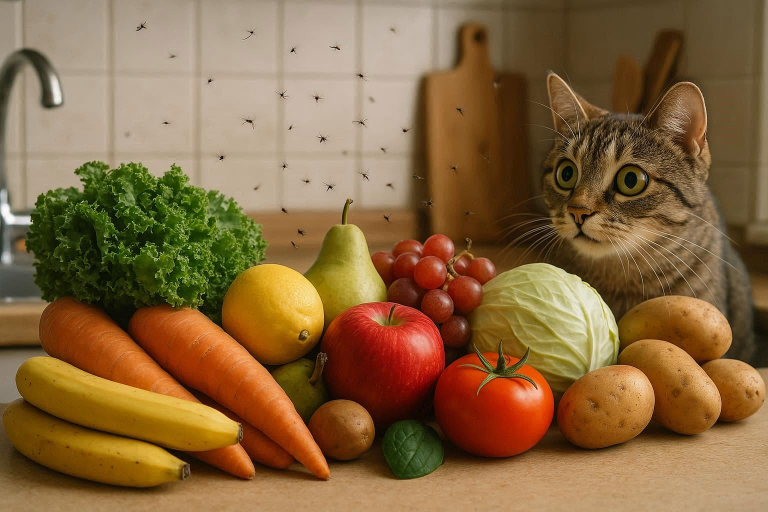Gnats in the kitchen can be more than just a nuisance; they can drive anyone crazy. These tiny, flying insects seem to appear out of nowhere, swarming around food, sinks, and even the garbage. So, you might find yourself asking: Why do I have so many gnats in my kitchen? It’s a frustrating problem that seems to have no easy solution, but it’s one that many of us face from time to time. In this article, we’ll dive into why gnats are attracted to your kitchen, how to get rid of them, and most importantly, how to keep them from coming back.
What Are Gnats and Why Are They in My Kitchen?
Before we jump into how to get rid of gnats, let’s take a look at what they are and why they like hanging out in your kitchen.
Types of Gnats
Several types of gnats might invade your kitchen. The most common culprits are fungus gnats and drain flies.
- Fungus Gnats: These are often found around overwatered houseplants or in soil that’s too damp. Fungus gnats are attracted to the organic matter in moist environments, which makes your kitchen a perfect breeding ground.
- Drain Flies: If you’ve noticed gnats flying around your sink, it could be drain flies. These pests breed in decaying organic matter, often found in clogged drains, and they love damp environments.
Attraction to Kitchens
So, why are your gnats so keen on your kitchen? Kitchens provide plenty of what these little insects are looking for: moisture, organic material, and food. The moisture from your sink, damp sponges, and even overwatered plants create a breeding environment that gnats just love. Add in leftover food crumbs, rotten fruits, or dirty trash, and it’s a perfect recipe for a gnat invasion.
Gnat vs. Fruit Fly
It’s important to know the difference between gnats and fruit flies, as they are often confused. Fruit flies are typically attracted to ripened or rotting fruits and vegetables, whereas gnats are more drawn to decaying organic matter, including soil and trash. Though they may seem similar, understanding the difference helps in targeting the right solution.
Common Causes of Gnats in the Kitchen
Now that you know what gnats are and why they’re drawn to your kitchen, let’s explore the common causes that could be attracting them.
Food Sources
Spoiled fruits, vegetables, and sugary liquids are some of the top food sources that attract gnats. When fruits ripen and begin to rot, they release sweet aromas that gnats can’t resist. It’s essential to regularly check your fruits and vegetables and dispose of any that are past their prime.
Standing Water
Gnats love moisture, and standing water is like a free buffet for them. Puddles from leaks, wet dishes, or even a forgotten sponge left in the sink can create an environment for gnats to thrive. These insects breed in stagnant water, so it’s crucial to keep things dry.
Dirty Drains
Your kitchen drain might be a hidden hotspot for gnats. When food debris, grease, and soap accumulate in your drain, it can create a breeding ground for gnats. The organic material inside can feed the larvae and help them grow into adult gnats. Regular drain cleaning can go a long way in keeping gnats at bay.
Houseplants
Houseplants can be a hidden source of gnats. If you tend to overwater your plants, the soil may stay moist for too long, making it a perfect breeding spot for fungus gnats. They thrive in damp environments, so it’s important to avoid overwatering and let your plants dry out between watering.
Trash Bins
A neglected trash bin is another major contributor to a gnat infestation. Organic waste like food scraps, coffee grounds, and other leftovers can attract gnats if not disposed of properly. Be sure to take out your trash regularly, and consider using a tightly sealed bin to keep gnats out.
Why Am I Getting So Many Gnats in My House?
You might be wondering, Why am I getting so many gnats in my house? Gnats don’t just show up in the kitchen; they can invade other parts of your Cleaning Guide for Home & Kitchen home as well. Let’s take a closer look at why gnats may be appearing in areas other than your kitchen.
Indoor Attractants
Besides the kitchen, gnats are also drawn to other damp or organic environments in your home. Bathrooms, with their humidity and standing water, are common spots for gnats to appear. Bedrooms may also have gnats if there are houseplants or moisture issues, like a leaky air conditioner.
Environmental Factors
Environmental conditions also play a role in gnat invasions. Warm, humid weather creates an ideal environment for gnats to breed and thrive. In spring and summer, you’re more likely to see an influx of gnats, especially if your home is a breeding ground for them. The changing seasons often mean more moisture in the air, and this is when you’re most likely to notice gnats.
How to Get Rid of Gnats in the House Quickly
If you’re dealing with a gnat infestation, it’s time to take action. Here’s how to get rid of gnats in your house quickly.
Cleanliness is Key
The best way to eliminate gnats is to keep your home clean. Make sure to wipe down countertops, clean out trash bins regularly, and clear up food spills immediately. Don’t forget about your drains – regular cleaning can prevent them from becoming gnat hotspots.
Use Traps
Setting up traps is an easy and effective way to capture gnats. A simple apple cider vinegar trap can lure gnats in. Just fill a small bowl with apple cider vinegar and add a drop of dish soap. The gnats will be attracted to the vinegar, but the soap will trap them.
Dealing with Drains
To clean your drains, pour a mixture of baking soda and vinegar down the drain. This will help break up any gunk and kill any gnat larvae present. Follow up with hot water to flush everything down.
Repellents and Pesticides
If you prefer to go the store-bought route, there are several gnats-specific repellents and pesticides available. Be sure to choose a safe, non-toxic option if you’re concerned about the environment or pets.
How to Get Rid of Gnats in the Kitchen
Now that we’ve covered how to get rid of gnats in your house, let’s focus on the kitchen. Here are some targeted solutions for a gnat-free kitchen.
Eliminate Food Sources
Clean up food spills immediately and store fruits and vegetables in the fridge or airtight containers. Check your pantry for any food that might be attracting gnats and dispose of it.
Dealing with Standing Water
Fix any leaks in your sink or faucet and wipe down any standing water left in the sink or on countertops. Avoid leaving wet sponges or towels around.
Use of Essential Oils
Certain essential oils, like peppermint, eucalyptus, and lavender, can help repel gnats. Add a few drops to a cotton ball and place them near your sink or other problem areas.
Home Remedies for Kitchen Gnats
If you prefer natural solutions, vinegar traps are a great option. You can also try spraying a mixture of water and citrus juice around the kitchen to keep gnats away.
Gnats in Bedroom: No Food, So Why Are They There?
You may wonder why gnats are in your bedroom, even if there’s no food. Let’s break down some of the reasons why gnats might be in your sleeping space.
Explanation of Bedroom Gnat Presence
Gnats are attracted to moisture, so leaky windows or humid air in the bedroom could be drawing them in. Additionally, if you have houseplants in your bedroom, the damp soil could be a breeding ground for fungus gnats.
Preventive Measures
To keep gnats out of the bedroom, inspect your houseplants for overwatering and check for any signs of standing water or leaks. Using essential oils like lavender or peppermint in your bedroom can also help.
Gnat Bites: Do Gnats Bite?
You’ve probably heard that gnats don’t bite, but let’s clarify.
Understanding Gnat Bites
Most gnats don’t bite humans, but some species, like biting midges or no-see-ums, can cause irritation. The bites may leave small red bumps that itch. If you do get bitten, applying an anti-itch cream can help relieve the symptoms.
Precautions
To avoid getting bitten, try using insect repellent or wearing long sleeves and pants when in areas prone to gnats.
Why Are There So Many Gnats Outside?
Gnats are not just an indoor problem; they’re common outside too. Here’s why.
Outdoor Gnat Population
Gnats love damp, decaying organic material like rotting leaves or moist soil. Your yard, garden, or any nearby areas with standing water can become a breeding ground for gnats.
Seasonal Considerations
Gnats are more prevalent during the warmer months when moisture is abundant. You may notice an increase in their population during spring and summer.
How to Keep Outdoor Gnats Away
To keep gnats away from your outdoor spaces, regularly clear away debris, ensure proper drainage in your garden, and keep outdoor trash bins tightly sealed.
How to Prevent Gnats from Returning to Your Kitchen
After getting rid of gnats, it’s crucial to prevent them from coming back. Here’s how to maintain a gnat-free kitchen.
Continual Cleanliness
Make cleaning a habit. Wipe down surfaces, dispose of food scraps, and regularly clean drains to eliminate any potential breeding grounds.
Fix Leaks and Drain Issues
Ensure that all leaks are repaired, and drains are cleaned regularly. This eliminates moisture sources that gnats love.
Proper Waste Disposal
Take out your trash regularly and use a sealed bin to prevent gnats from being attracted to decomposing organic waste.
FAQ
How to get rid of gnats in house home remedy?
Use natural remedies like apple cider vinegar traps, essential oils, or citrus sprays.
What’s the difference between gnats and fruit flies?
Gnats are attracted to decaying organic matter, while fruit flies prefer ripe or rotting fruits.
Can gnats bite humans?
Most gnats don’t bite, but certain species can cause irritation with small bites.
How do I get rid of gnats in the kitchen fast?
Clean up food spills, use vinegar traps, and eliminate standing water.
How to get rid of gnats in the bedroom?
Check plants for overwatering, eliminate moisture sources, and use essential oils as repellents.
Why are there so many gnats outside my house?
Gnats are attracted to damp, decaying organic matter. Outdoor moisture and debris create ideal conditions for them.
Conclusion
Gnats in the kitchen are more than just a nuisance – they are a sign of underlying issues such as moisture, organic waste, and poor cleaning habits. By identifying the common causes of gnat infestations and implementing the solutions provided, you can quickly get rid of these tiny pests and prevent them from coming back. Regular cleanliness, proper waste disposal, and eliminating moisture sources are key to keeping your kitchen gnat-free for good. Happy cleaning!

